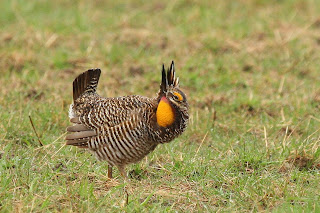Listen to the commentary
Real Audio : MP3 download
A week ago Saturday, just before dawn, I was ensconced in a plywood-sided blind with my friend Greg Lambeth at the Prairie Ridge State Natural Area, southeast of Effingham. Over the rat-a-tat noise of rain on the tin roof, and through the fog of a nap, I was awakened by a clipped whisper, “They’re here!”
“They” were greater prairie chickens, and despite the rain and gusting wind they had begun to congregate on the communal breeding ground, or “lek,” our blind looked onto.
Greater prairie chickens, which belong to the grouse family, are not striking to look at under most circumstances. They’re about the size shape of a small barnyard chicken, marked by beige and brown barring. But on mornings in March and April when males congregate on the lek, they strut their stuff in a show that fully justifies the effort required to observe it.
 After pausing to survey the field a prairie chicken bows, and stretches his neck forward, creating a horizontal line from tail to head. Suddenly, his tail flips up into a fan and on either side of his throat out flashes a round expanse of featherless skin the size and color of a navel orange. The inflation of these air sacs produces a low, otherworldly call, known as booming, that may be heard a mile or more away. Raising long feathers on the back of his neck into a headdress, he completes the performance by dancing, a hyper-fast stutter step that may propel him in partial circles.
After pausing to survey the field a prairie chicken bows, and stretches his neck forward, creating a horizontal line from tail to head. Suddenly, his tail flips up into a fan and on either side of his throat out flashes a round expanse of featherless skin the size and color of a navel orange. The inflation of these air sacs produces a low, otherworldly call, known as booming, that may be heard a mile or more away. Raising long feathers on the back of his neck into a headdress, he completes the performance by dancing, a hyper-fast stutter step that may propel him in partial circles. Male prairie chickens on the lek also vie for choice territories in brief, but surprisingly violent battles. It’s like watching a ballet where occasionally one dancer crosses the stage to butt heads with another, or even attack him with a flying kick.
Male prairie chickens on the lek also vie for choice territories in brief, but surprisingly violent battles. It’s like watching a ballet where occasionally one dancer crosses the stage to butt heads with another, or even attack him with a flying kick.Prior to European settlement, prairie chickens thrived in the grasslands of Illinois, and their numbers even increased during the middle years of the nineteenth century, thanks to the introduction of high-energy grain fields into their favored habitats. The hunting of prairie chickens for sale as food and the intensification of agriculture in the years following the Civil War brought on a long decline that would have ended with their extirpation from the state were it not for creation of refuges at Prairie Ridge in the 1960s.
And habitat preservation alone was not enough to save them. The population of prairie chickens surviving in Illinois was so small and so isolated from remaining populations in other states that by the late 1980s it had lost the genetic diversity needed for successful reproduction. What scientists call a “population bottleneck” had been reached.
The Illinois Department of Natural Resources resolved this problem during the 1990s by translocating prairie chickens to Prairie Ridge from healthier populations in Kansas, Minnesota and Nebraska.
The prairie chickens my friend and I observed are part of a population that has remained relatively stable over the past decade. According to Scott Simpson, long-time manager at Prairie Ridge, the total number of prairie chickens there currently includes about 180 birds.
You can link to video of prairie chickens booming here.
Better still, you can see them for yourself, either from the roadside or from your own spot in a blind at the Prairie Ridge State Natural Area.



